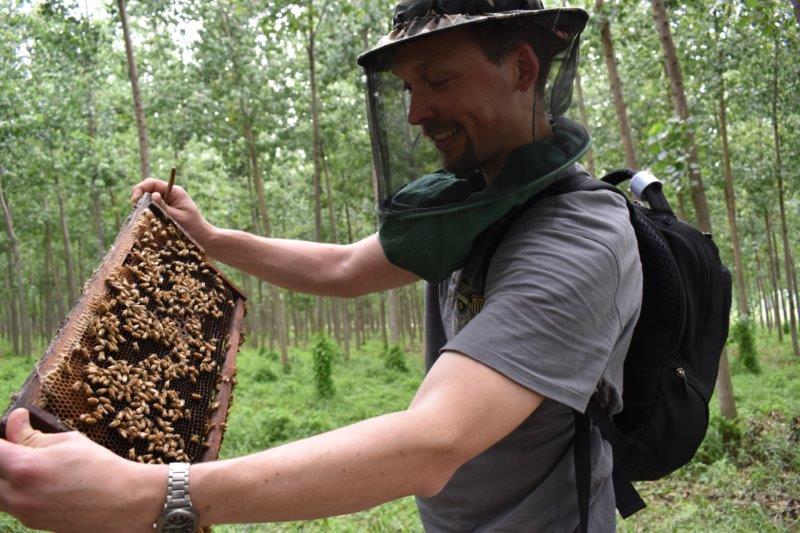Bee Keeping Management methods
1. कॉलोनी की ताकत की निगरानी करें
• कॉलोनी का नियमित निरीक्षण करें ताकि जनसंख्या, ब्रूड पैटर्न, और भोजन के भंडार का आकलन किया जा सके।
• सुनिश्चित करें कि रानी (क्वीन) स्वस्थ है और लगातार अंडे दे रही है।
• कमजोर रानी को हटाकर ताकतवर रानी से बदलें।
2. पर्याप्त भोजन की आपूर्ति करें
• कॉलोनी में हमेशा पर्याप्त शहद और पराग (पोलन) का भंडार सुनिश्चित करें, खासकर भोजन की कमी के दौरान।
• कमी के समय चीनी का घोल या पोलन का विकल्प दें, लेकिन अधिक मात्रा में न दें क्योंकि इससे लूट (रोबिंग) की समस्या हो सकती है।
3. झुंड बनाने (स्वार्मिंग) को नियंत्रित करें
• कॉलोनी में भीड़भाड़ होने से रोकने के लिए अतिरिक्त जगह (सुपर्स) जोड़ें या मजबूत कॉलोनियों को विभाजित करें।
• निरीक्षण के दौरान स्वार्म सेल्स को हटा दें।
• मधुमक्खियों को फैलने के लिए पर्याप्त जगह और वेंटिलेशन प्रदान करें।
4. कीट और बीमारियों का प्रबंधन
• वेरोआ माइट्स, वैक्स मॉथ्स और अन्य कीटों की निगरानी और नियंत्रण करें।
• नियमित स्वास्थ्य जांच करें और बीमारियों का सही तरीके से उपचार करें।
• स्वच्छता बनाए रखें और पुराने छत्तों को बदलते रहें।
5. हाइव का तापमान बनाए रखें
• गर्मियों में छत्ते को हवादार रखें ताकि मधुमक्खियां गर्मी से बच सकें।
• सर्दियों में छत्तों को इन्सुलेशन या विंडब्रेक प्रदान करें ताकि ठंड से बचाव हो सके।
6. संसाधनों को संतुलित करें
• कमजोर और मजबूत कॉलोनियों के बीच ब्रूड, मधुमक्खियां, या शहद स्थानांतरित करें।
• किसी भी कॉलोनी को बहुत कमजोर या बहुत अधिक शक्तिशाली होने से बचाएं।
7. कॉलोनी के प्रजनन का समर्थन करें
• आवश्यकतानुसार प्राकृतिक रानी प्रतिस्थापन को बढ़ावा दें या कृत्रिम तरीके से नई रानी दें।
• रानी के अभाव के संकेतों पर ध्यान दें और समय पर नई रानी को पेश करें।
8. मौसमी परिवर्तनों को समझें
• मौसमी बदलावों के अनुसार हाइव प्रबंधन में बदलाव करें।
• मधु प्रवाह (नेकटर फ्लो) की पूर्वानुमान लगाएं और कॉलोनियों को शहद उत्पादन के लिए तैयार करें।
9. तनाव से बचाएं
• निरीक्षण के दौरान कॉलोनी को कम से कम परेशान करें।
• छत्तों को सुरक्षित, छायादार और शिकारी से मुक्त स्थान पर रखें।
10. रिकॉर्ड रखें
• हाइव की स्थिति, उपचार, और निरीक्षण का विस्तृत रिकॉर्ड रखें।
• इन रिकॉर्ड्स का उपयोग प्रवृत्तियों को समझने और भविष्य की योजना बनाने के लिए करें।
11. स्वयं को शिक्षित करें
• स्थानीय मधुमक्खी पालन पद्धतियों, जलवायु और वनस्पतियों के बारे में जानकारी रखें।
• मधुमक्खी पालन समुदायों से जुड़ें और अनुभव साझा करें।
संतुलित प्रबंधन से आपकी कॉलोनी स्वस्थ, उत्पादक और चुनौतियों का सामना करने में सक्षम बनी रहेगी।



